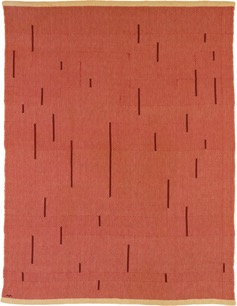
With Verticals, 1946
With Verticals, 1946
Pictorial weaving; red cotton on linen
154.9 x 118.1 cm
The Josef and Anni Albers Foundation, Bethany, Connecticut
I tried to get my beliefs, feelings, and ideas into that other area which is in the direction of art, pictorical weavings. Here, I’m concerned with form, line, color, proportions, and surface [1]
Anni Albers (Berlin, 1899–Orange, Connecticut, 1994) enrolled in 1922 at the Bauhaus, a revolutionary school that took a transversal approach to arts, crafts, architecture and industry through design or the production of forms that can be transferred to industry, handicrafts or art. In the school’s textile workshop, the painter and weaver Gunta Stölzl taught Albers how to apply the concepts of modern art to weaving, and to experiment with unconventional materials like metallic threads or cellophane. This encouraged Albers to develop innovative textiles that would simultaneously perform architectural, decorative and artistic functions in a domestic setting [2]. Thanks to her exploration of the techniques of hand weaving during her years in the Bauhaus, Albers became a very influential figure among both teachers and students.
At the start of the 1930s, with the advance of National Socialism in Germany, the artists and teachers at the Bauhaus started to worry about the school’s future. In 1933, the Nazi party closed down the school. Anni and her husband Josef accepted an invitation from the architect Philip Johnson to take up teaching positions at Black Mountain College, an experimental new school in North Carolina. Their presence was instrumental in winning the school a reputation as one of the most advanced in the country. In her classes and workshops at Black Mountain, Albers experimented with an individualized teaching method aimed at the acquisition of knowledge through sensory experiences and investigation of unconventional materials. Students also learned to draw and read weaving patterns, make knots, calculate the warp and weft, set up the loom, analyze the relations between colors and, finally, weave.
During their years in North Carolina, Anni and Josef Albers went on many trips to Mexico and South America. There Anni visited indigenous markets, where she bought textiles and other objects that inspired several of her designs and influenced her work. With local women, she also learned about the autochthonous clothmaking techniques. Albers thought the manual work done in these rural areas was formally very sophisticated, and saw that its economic impact was essential for those communities. However, she was convinced that mechanical production with industrial looms would better satisfy the needs of a modern society. Between 1936 and 1946, after her return to Black Mountain College, she drew inspiration from her travels to make many pictorial weavings and some large-forrmat pieces, such as Monte Albán (1936), Ancient Writing (1936) and With Verticals (1946).
With Verticals (1946) was the last of the large-format works she created after her travels. In it she uses a warm and limited range of colors, with red and gold fibers for the weft of the fabric and black fibers for the vertical and discontinuous warp threads. The interaction between perpendicular and parallel lines created by manipulating the warp and weft shows its “orchestration” (as the artist liked to say), the detailed planning of the threads. With Verticals (1946) is one of her most important ‘pictorial weavings’, a term with which Albers gave the woven piece the same status as the picture in painting – that of an object with a purely aesthetic significance and intention, with no utilitarian purpose [3].
At Black Mountain College, teachers, students and invited artists interacted in the relaxed atmosphere of community life on campus, and collaborative and collective art works soon started to appear. Anni Albers met Alex Reed when he was a student, and the two started to collaborate after a trip they took together to Oaxaca, Mexico. There they discovered the pre-Columbian jewels of Monte Albán, made on the basis of combinations of different materials like pearls, seashells, rock crystal and gold. Inspired by what they had seen, Albers and Reed created a collection of jewelry from hardware store items, like paper clips, hairpins, washers, nuts, or water filters. By using these domestic objects, the artists produced a collection of jewels that redefines the value of adornment by opposition with the conventional notion of luxury.
Preguntas
Look closely at With Verticals (1946) by Anni Albers. Take some time to concentrate on all the details. What do you see? Can you make out a pattern of some kind? Describe the way Albers has used color in this piece. Does it suggest any particular feeling or sensation to you?
Albers made this piece after spending several months in Latin America. If this work had been inspired by a landscape, what do you think it would have been like? Does it remind you of any particular place you have been to?
With Verticals (1946) is one of the first of the works the artist called “pictorial weavings”. Why do you think she gave them that name? Do you think textiles can have the same artistic value as a painting or a sculpture? Give reasons for your answer.
Now look at the jewels made by Albers and Reed. Can you recognize any of the objects they were made from? Where might you find these items? How do you think the public reacted when they saw necklaces made with these techniques?
Albers and Reed called the pieces in this collection “anti-luxury jewelry”. Why do you think they gave them this name? How far do you think the value of a piece is related to the material it is made from? Would you wear one of these pieces?
Many of Albers’ textiles are made industrially. Do you think it is important for works of art to be unique, or to be hand-made? Why? Is it possible that a utilitarian function takes artistic value away from an object? Give reasons for your answer.
